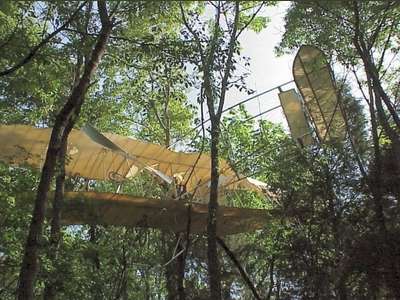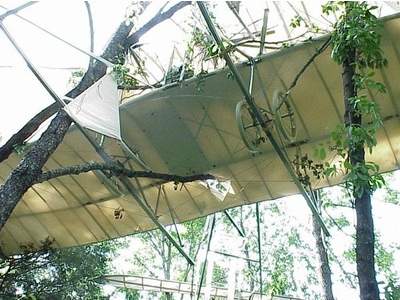 Builder/pilot Ken Hyde
talked with ANN, and told us, "I could be doing better,
but I'm OK." He broke his right ulna (right lower arm), and he has
surgery scheduled for Wednesday, when, "they'll bolt it back
together." He went straight to the airplane's condition: "I'm OK;
the airplane is being taken apart. It's a step backwards, but it
will fly again."
Builder/pilot Ken Hyde
talked with ANN, and told us, "I could be doing better,
but I'm OK." He broke his right ulna (right lower arm), and he has
surgery scheduled for Wednesday, when, "they'll bolt it back
together." He went straight to the airplane's condition: "I'm OK;
the airplane is being taken apart. It's a step backwards, but it
will fly again."
Contrary to early reports, he told us,
"We did not spin in. We'd be in a lot worse shape,
if we had."

"What basically happened, he said, was, "We were doing taxi
tasts, and we got to a point where had to either fly, or go through
some ditches." So he took off. "We got about a mile or two, and did
two or three turns. On the fourth turn, it was obvious that we were
going to hit something -- power lines or trees -- so I let the
outer wing panels take the brunt of it."
First flight wasn't planned that way.
"This was the first time it was pulled into the air," Ken said.
"What we were trying to do was to see what our taxi limitations
were, to get it up to speed -- that's how we got ourselves into a
corner." Flying wasn't in the plans, but flying probably saved a
lot more (just as the Wright Redux folks figured out a couple weeks
back). "In retrospect, I probably could have gotten hurt just as
badly, going into the ditch, or something."
The original Wright engine (Serial Number 20) worked like a
charm.
Fortunately, there were no detectable systems or manufacturing
failures.
Ken had a way of telling us that he thinks he knows what
happened: "We'll find out what went wrong," he said; then he pretty
much eliminated the airplane from the equation. "There was nothing
that I see that was mechanical..."

"The [Model] Bs," Ken related, "were quite dependable, even
back then." This airplane is powered by an actual, original
Wright engine, that had been in storage in Dayton for
years. Ken told us, "It came from the grandson of the guy who owned
Lincoln Storage in Dayton (OH). He had the Wright engine, and there
was finally some $216 due on it. He contacted the Wrights, saying
that they should either pay for it, or it was going to a museum;
Orville said they could keep it. We called everybody in Dayton with
that last name, until we finally found the grandson." The engine
itself, Ken says, "...has about 8 hours now, in dyno and
demonstration test." The engine was totally undamaged.
Still on schedule...
This machine, a 1911-style Model B, was being built for a
television special, and, Ken notes, "We'll get the Nova film back
on schedule." As for his other Wright projects, "The '03 Flyer is
on schedule. The pilots are training, and we'll all be ready. We're
dedicated to find out exactly what happened."
Building it was hard. Flying it is harder.
Mr. Hyde said that, concerning these projects, "The hardest part
is raising the funds. The second is not to change anything." Flying
it wasn't easy, either: "These things are unforgiving, and
they're not stable. You've got to fly 'em all the time." The brief
flight confirmed another belief about the Wrights: "It clearly
demonstrates that these airplanes were very difficult to fly --
Orville and Wilbur were way ahead of us." It's a learning
experience, he noted: "we're working hard to learn everything we
can, just like the Wrights... We're concerned about all the Wright
Experience pilots."

What about that simulator?
It's helpful, Ken said, within its limitations. "The simulator
is basically a procedural trainer -- there's no G forces. Think of
it like a bus steering wheel -- you turn it, the picture changes.
That's kind of the way we practiced." In the real world, though,
"The trees were growing faster than I was climbing."
Even when you know what's going on, though, reaction time isn't
lightning-quick: "The controls weren't inuitive, either -- fore and
aft, for wing warping, for instance," he noted.
Both the building and the flying have one main thing in common:
that was then; this is now. "I've always said that about flying
these machines, the hardest part is to unlearn what we've already
learned about flying," Ken said. "I think I proved that last
night."
 ANN's Daily Aero-Term (04.26.24): DETRESFA (Distress Phrase)
ANN's Daily Aero-Term (04.26.24): DETRESFA (Distress Phrase) ANN's Daily Aero-Linx (04.26.24)
ANN's Daily Aero-Linx (04.26.24) Airborne 04.22.24: Rotor X Worsens, Airport Fees 4 FNB?, USMC Drone Pilot
Airborne 04.22.24: Rotor X Worsens, Airport Fees 4 FNB?, USMC Drone Pilot Airborne 04.24.24: INTEGRAL E, Elixir USA, M700 RVSM
Airborne 04.24.24: INTEGRAL E, Elixir USA, M700 RVSM Airborne-NextGen 04.23.24: UAVOS UVH 170, magni650 Engine, World eVTOL Directory
Airborne-NextGen 04.23.24: UAVOS UVH 170, magni650 Engine, World eVTOL Directory






